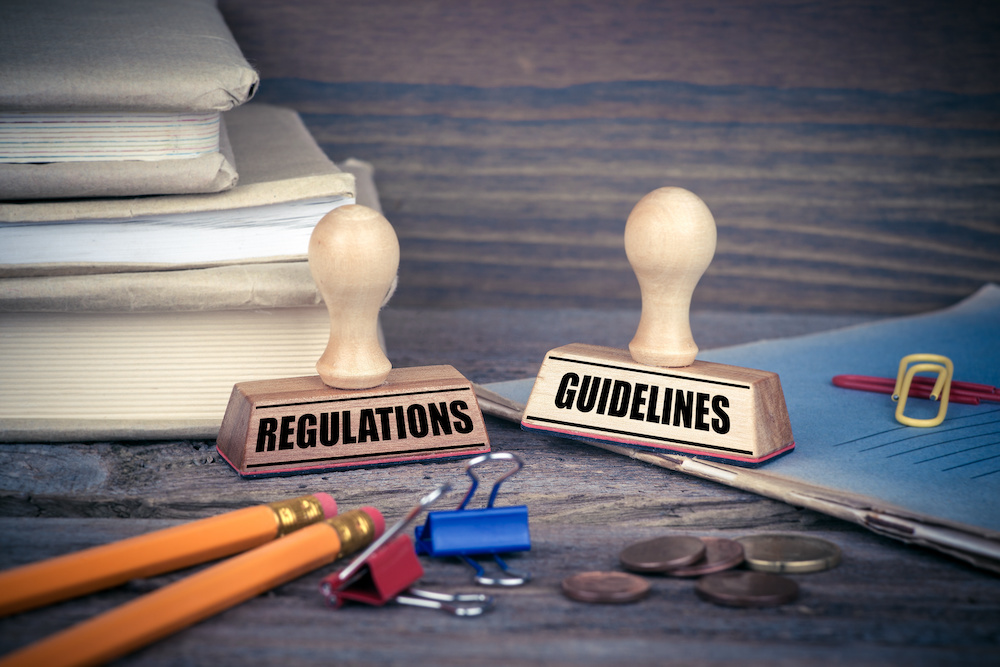The United States is expected to generate 10 million tonnes of PV waste by 2050, making the country the second largest contributor to PV waste after China1. In this post, we will cover PV module waste regulations in the United States.
Are there any PV-specific waste regulations in the United States?
Federal level
At present, no federal regulations exist specific to PV module waste in the United States2. At the federal level, PV modules are treated as solid waste; some PV modules are hazardous solid waste, while others are considered non-hazardous solid waste, depending on the materials contained in the modules. Solid waste (hazardous/non-hazardous solid waste) is regulated federally by the Resource Conservation and Recovery Act (RCRA)3. Under the RCRA, generators of PV waste must determine whether PV modules are hazardous waste by conducting the toxicity characteristic leaching procedure (TCLP) or using generator knowledge4. If waste modules pass the TCLP, they are classified as solid waste and will be subject to RCRA Subtitle D. If they fail the TCLP or if generators of waste modules determine modules are hazardous based on their past experience, waste modules are then considered hazardous waste and become subject to RCRA Subtitle C3 4.
State and Local level
While there are currently no federal laws specific to PV module waste, several states have been implementing regulations to promote proper end-of-life management of PV modules.
- California: In 2020, California’s Department of Toxic Substances Control (DTSC) passed regulation R-2017-045 to reclassify discarded PV modules as universal waste. Under California’s universal waste program, discarded PV modules are managed with less stringent rules than the state’s hazardous waste regulations — restrictions on toxic materials like lead, cadmium and selenium still apply6 7. The new regulation went into effect on January 1, 2021, making California the first state in the U.S. to classify waste PV modules as universal waste6.
- Washington: In 2017, Washington passed a new bill and created Photovoltaic Module Stewardship and Takeback Program8, which is based on the product stewardship approach, also called Extended Producer Responsibility (EPR) approach9 10. The program is expected to take effect on July 1, 2025 and is applicable to PV modules purchased after July 1, 20179. Under the new rule, manufacturers of PV modules are responsible for financing the takeback and recycling program of waste modules9. Washington is the first state in the U.S. to introduce the EPR program11.
- Niagara County, New York: In June 2021, Niagara County passed a law12 to require manufacturers to fund and manage the takeback and recycling of PV modules, making the county the first local government and the second jurisdiction after Washington to introduce an EPR scheme13. Each manufacturer or stewardship organization acting on behalf of a manufacturer needs to submit a stewardship plan to the county detailing how the takeback and recycling system will be financed and managed12. Since August 1, 2022, no manufacturer, distributor, retailer or installer has been allowed to sell PV modules in the county unless the manufacturer is conforming to Niagara County Local Law No.414.
Table 1 PV-specific Regulations in the U.S.3 4 5 7 11
| Solar PV-specific Regulation | PV Module Waste | Authority | |
|---|---|---|---|
| Federal level | No. Must follow the Resource Conservation and Recovery Act (RCRA). | Solid waste Generators of solar panel waste are responsible for determining whether solar panels are hazardous waste by conducting the toxicity characteristic leaching procedure (TCLP) or using generator knowledge. If PV modules pass the TCLP: solid waste (Subtitle D) If PV modules fail the TCLP or if generators of waste modules determine modules are hazardous using generator knowledge: hazardous waste (Subtitle C) | The U.S. Environmental Protection Agency (U.S. EPA) |
| California | Yes DTSC Regulation R-2017-04 | Reclassified as universal waste. *Effective date: January 1, 2021 | The California Department of Toxic Substances Control (DTSC) |
| Washington | Yes Chapter 70A.510.010 RCW (The Washington Photovoltaic (PV) Module Stewardship and Takeback Program) | Extended producer responsibility (EPR) approach *Expected effective date: July 1, 2025 | Washington State Department of Ecology |
| Niagara County, New York | Yes Niagara County Local Law No.4 | Extended producer responsibility (EPR) approach *Effective date: August 1, 2022 | Niagara County, New York |
With the U.S. being one of the primary contributors to PV module waste, PV-specific regulations and initiatives in the U.S. will greatly impact the PV reuse and recycling market. In our next post, we will look at how the U.S. solar industry is addressing solar PV waste concerns.
References
- IRENA and IEA-PVPS, “End-of-Life Management: Solar Photovoltaic Panels,” 2016. Accessed: Jan. 05, 2023. [Online]. Available: https://www.irena.org/publications/%202016/Jun/End-of-life-management-Solar-Photovoltaic-Panels ↩︎
- T. L. Curtis, H. Buchanan, G. Heath, L. Smith, and S. Shaw, “Solar Photovoltaic Module Recycling: A Survey of U.S. Policies and Initiatives,” 2021. Accessed: Jan. 31, 2023. [Online]. Available: https://www.nrel.gov/docs/fy21osti/74124.pdf ↩︎
- United States Environmental Protection Agency, “End-of-Life Solar Panels: Regulations and Management.” https://www.epa.gov/hw/end-life-solar-panels-regulations-and-management (accessed Feb. 01, 2023). ↩︎
- United States Environmental Protection Agency, “Solar Panel Frequent Questions.” https://www.epa.gov/hw/solar-panel-frequent-questions (accessed Feb. 01, 2023). ↩︎
- Department of Toxic Substances Control (DTSC), Final Regulatory Text April, 2020 Photovoltaic modules (PV modules) – Universal Waste Management Department of Toxic Substances Control reference number: R-2017-04 Office of Administrative Law Notice File Number: Z-2019-0409-04. Accessed: Feb. 01, 2023. [Online]. Available: https://dtsc.ca.gov/wp-content/uploads/sites/31/2020/10/C.-RegTextFinal-PVM-09252020_no-watermark-PV-Regulations.pdf ↩︎
- Department of Toxic Substances Control (DTSC), “California is the First in the Nation to Add Solar Panels to Universal Waste Program.” https://dtsc.ca.gov/2020/10/26/news-release-t-17-20/ (accessed Feb. 01, 2023). ↩︎
- T. L. Curtis, H. Buchanan, G. Heath, L. Smith, and S. Shaw, “Solar Photovoltaic Module Recycling: A Survey of U.S. Policies and Initiatives,” 2021. Accessed: Feb. 03, 2023. [Online]. Available: https://www.nrel.gov/docs/fy21osti/74124.pdf ↩︎
- Washington State Legislature, RCW 70A.510.010—Photovoltaic module stewardship and takeback program—Definitions—Requirements—Enforcement—Penalty—Fees—Rule making. Accessed: Feb. 01, 2023. [Online]. Available: https://app.leg.wa.gov/rcw/default.aspx?cite=70A.510.010 ↩︎
- Washington State Department of Ecology, “Solar panels.” https://ecology.wa.gov/Waste-Toxics/Reducing-recycling-waste/Our-recycling-programs/Solar-panels (accessed Feb. 01, 2023). ↩︎
- Washington State Department of Ecology, “Our recycling programs.” https://ecology.wa.gov/Waste-Toxics/Reducing-recycling-waste/Our-recycling-programs (accessed Feb. 07, 2023). ↩︎
- Northwest Product Stewardship Council, “First solar product stewardship law passed in Washington State.” https://productstewardship.net/news/first-solar-product-stewardship-law-passed-washington-state (accessed Feb. 07, 2023).
↩︎ - Niagara County Legislature, Resolution Approving Rules and Regulations for Local Law No.4 of 2021. Accessed: Feb. 01, 2023. [Online]. Available: https://cms5.revize.com/revize/niagaracounty/Document_center/Department/S-Z/Solar/Solar-Law.pdf ↩︎
- Product Stewardship Institute (PSI), “Niagara County Passes Nation’s 2nd Solar Panel Producer Responsibility Law.” https://productstewardship.us/press_releases/niagara-county-passes-nations-2nd-solar-panel-producer-responsibility-law/ (accessed Feb. 01, 2023). ↩︎
- Niagara County, “Niagara County Solar Panel Recycling Local Law.” https://www.niagaracounty.com/government/county_information/niagara_county_solar_panel_recycling_local_law.php (accessed Feb. 01, 2023). ↩︎


